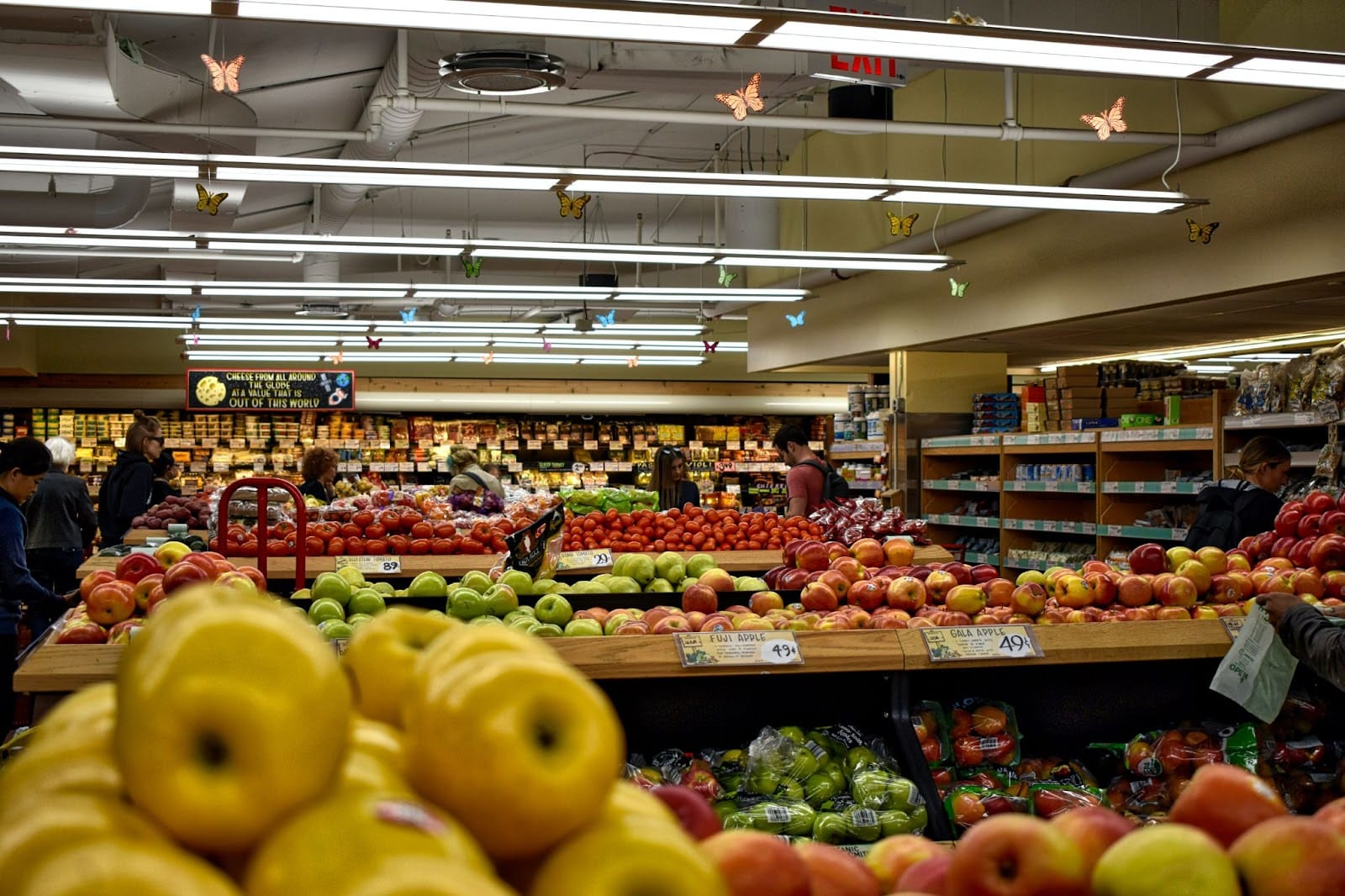Consumers are becoming increasingly interested in plant-based food and drink, with the global market now estimated to be worth a staggering $44.2 billion worldwide – up $8.6 billion from 2021.1 Multiple channels of revenue are responsible for this exponential growth, but certainly, supermarkets and online retailers are playing a massive part. In fact, 77% of people who buy plant-based products make their purchases at traditional supermarkets, and 20% online.2 Not all consumers are on board yet though, with often-subconscious barriers hindering prospective purchasers from putting meat- and dairy-free items in their baskets. So, what are some of these barriers and can we eliminate any of them? How can we increase the purchases of plant-based products in retail settings, in-store and online?
Read on to learn four quick ways for retailers to increase plant-based product sales, without adding shelf space.
1. Promote plant-based products next to animal-based products in-store and online
The location of plant-based products in stores and online really affects customer pick-up and purchase rates. Where and how you position them on a shelf and in which aisle or online category really matters. With animal-based products still dominating supermarket shelves and e-commerce sites, and with location in mind, how can we give a fair chance to plant-based items? It’s simple: by grouping them next to or near their conventional counterparts on shelves and on websites.

The reason that integrated merchandising (fully or partially) works to increase sales is because it puts plant-based products in front of the largest consumer audience: flexitarians, who are responsible for up to 90% of sales of plant-based alternatives.3 A recent pan-European Union (EU) survey by ProVeg International found that 30% of EU consumers now identify as flexitarian, while only 7% identify as plant-based eaters.4 In some European countries, the number of people who identify as flexitarian is even greater. In Germany, for instance, over 50% of consumers identify as flexitarian.5 A similar trend is being seen in the United States (US), where nearly half of Americans regularly purchase both dairy and plant-based milk during their weekly shop.6
It’s not just the flexitarian sector that’s shifting away from meat – a substantial 27% of mixed eaters are becoming more open-minded about plant-based alternatives.7 By shifting the marketing focus of plant-based items from vegans to flexitarians and plant-forward eaters, retailers can unlock a total addressable market that is over 10 times larger! So, how can we use integrated merchandising to do this?

ProVeg Tips
ProVeg has extensive knowledge of flexitarian consumers in Europe, from general preferences to specific consumer sentiments regarding particular product categories. We regularly help retailers and brands with their plant-based merchandising, educational social media, and product development. Get in touch with us at [email protected].
At ProVeg, we recommend utilising what’s known as an ‘integrated-segregated’ approach, whereby plant-based products are grouped together but positioned within animal-based-product aisles. This merchandising technique, which takes plant-based products to where the most potential shoppers are, can boost sales and aid sustainability, while still allowing vegans to access their favourite products.
Category managers may worry that vegan consumers will struggle to find their favourite products if integrated-segregated aisles are created, yet vegan consumers will seek out plant-based food and drink no matter where these products are located. On the other hand, flexitarians and mixed eaters are less likely to venture into separate plant-based aisles. This is because, by grouping plant-based products in a ‘vegan’ aisle, you group them as ‘only for vegan consumers’ and not for flexitarians and reducetarians. Unsurprisingly, when asked what would help them choose healthier and more sustainable options, like plant-based meats, while shopping, 57% of consumers agreed that stocking meat-free products in the animal-based meat aisle would help.8
In 2021, US supermarket giant Kroger explored this concept with an experiment that ran across its stores. While some locations maintained separate plant-based and animal-based product aisles, other locations integrated these two aisles. The study found that integrating plant-based alternatives into conventional-meat aisles increased sales of plant-based products by 23%.9
Julie Emmett, Senior Director of Retail Partnerships at the Plant Based Foods Association, who helped Kroger with the study, commented on the research: “This proves that it is important for retailers to place plant-based meat where shoppers expect to find it: in the meat department.”10
Kroger even experienced an increase in sales in traditionally meat-heavy US areas, like the Midwest. Emmett added: “The increase in sales in the Midwest demonstrates there is a tremendous opportunity for plant-based meats to succeed everywhere, including in the nation’s heartland.”11 All it takes is the right merchandising!
Case Study: Greggs integrated placement
Greggs is a British bakery chain with over 2,000 stores across the country12 that made headlines by introducing a vegan version of their popular pork sausage roll. The alternative product is made with a Quorn filling and has a higher protein content than its pork counterpart.13 Greggs positions the vegan sausage rolls alongside the pork sausage rolls on its baked-goods counter, making the alternative product prominent and appealing to flexitarian consumers.
The results? Within the first seven weeks of being introduced in 2019, the new product increased company-wide revenues by 14%. By the six-month mark, the integrated vegan product had driven a 58% increase in revenue, compared to the previous year.1415
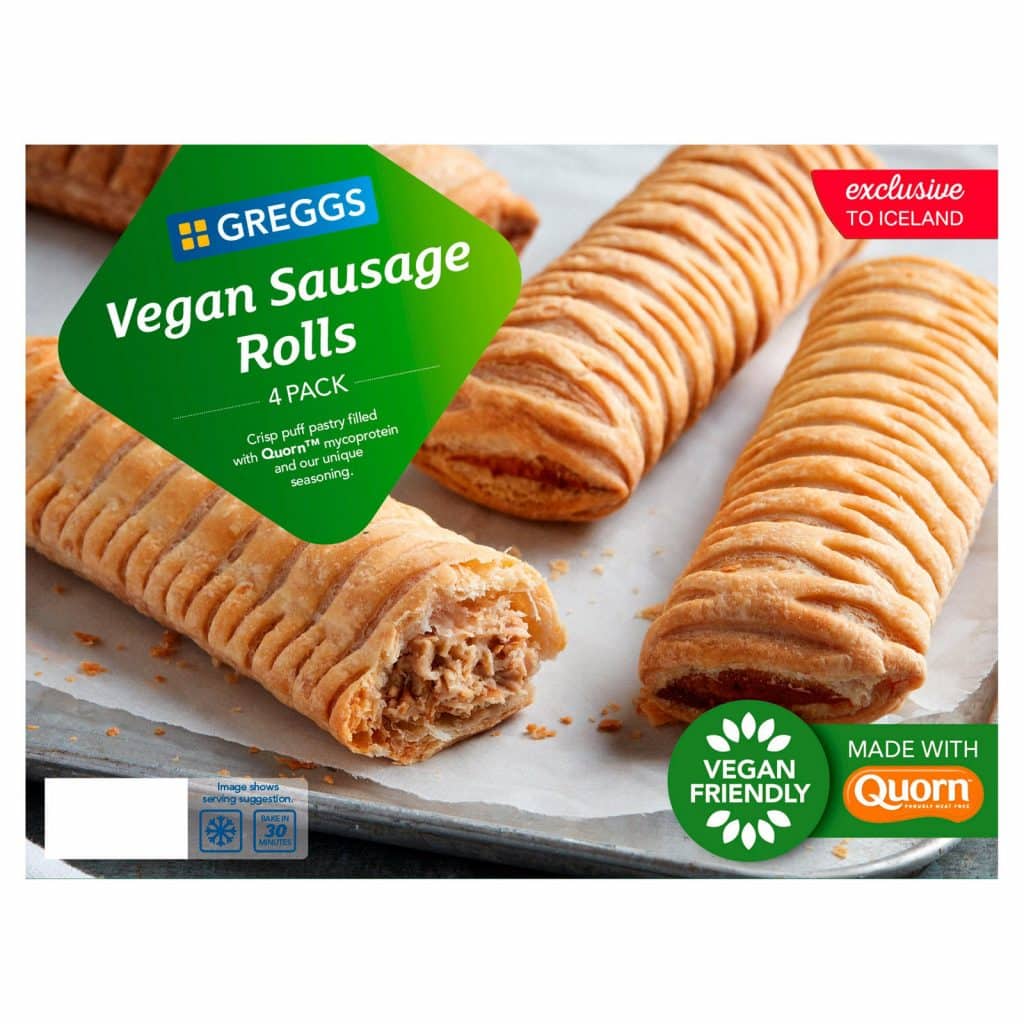
Greggs’ vegan sausage rolls achieved such mainstream popularity that the company launched them in supermarkets in 2021.
Greggs successfully increased their flexitarian sales of plant-based alternatives by:
- creating an analogue of a product with which consumers are familiar;
- making it the same price as the conventional product;
- placing it prominently on the same bakery shelves as the conventional version.
Developing and launching a plant-based product that becomes a runaway hit like the Greggs sausage roll requires the perfect mix of preparation, innovation, hard work, and promotion. ProVeg can help you to succeed with the entire process of launching a revamped plant-based menu that your consumers will love. To get started, reach out to us at [email protected].
In an interview with ProVeg, Bravura Foods Founder Lisa Gawthorne explained why integrated merchandising techniques work: “It’s an effective way to sway the thinking of people who may never have thought they would try these kinds of products. Plant-based foods become normalised when consumers see them with animal-meat-based products and that gives a higher chance of them being trialled.”
This tactic is informed by ‘choice architecture’ – the practice of influencing choice by ‘organising the context in which people make decisions’.16
In a previous article, ProVeg spoke to The Behavioural Insights Team, who are experts in change management (they were the ‘Nudge Unit’ in the British government, before becoming an international consultancy). They believe that choice architecture is vital for retail venues, saying that the “segregation of vegetarian items in shops is detrimental for multiple reasons”. The Behavioural Insights Team argues that segregation:
- reinforces the perception that plant-based products are different, which mixed eaters interpret as meaning ‘not for me’;
- makes it harder for flexitarian consumers to make the plant-based choices they would want to, because those options aren’t available in the places where they’re used to looking;
- subconsciously invites flexitarians to ignore vegan or vegetarian meals, because consumers often find choice overwhelming, so they tend to adopt “rapid and simple choice-elimination strategies” when shopping and will often disregard an entire aisle in order to make choosing easier.17
You can find out more about the principles of choice architecture by reading our previous article on the subject, here.
In a recent interview, Dr Filippo Bianchim, Senior Advisor at The Behavioural Insights Team, told ProVeg: “The best way to support flexitarians in reducing their meat intake is probably through interventions that make it easy to turn intentions into action, such as increasing the availability of tasty plant-based products, [or] making it easy to identify stores or restaurants that have a wide range of plant-based options.”18
“Shoppers are time-poor and low on bandwidth – in other words, their shopping habits are based on habit and expedience. They don’t try new aisles, they grab what they know and go,” says Emma Trim, Food Retail Consultant for Selfridges, in agreement.
The hope is that the more consumers are exposed to plant-based products, the more ‘normal’ these products will become. “In future years we might see a protein shelf instead of a meat shelf … It will not be an alternative anymore; it will just be a normal product in the eyes of the consumer – and it will be easy for the customer to find it all in one place,” stated a major Swiss food manufacturer in an interview with ProVeg.
2. Change the shelf placement of products for easier navigation
You’ve got your aisles sorted, with your plant-based products placed in prime positions alongside relevant animal-based products, so what’s next? How can we make aisles and shelves easier for customers to navigate, so that they can have a smoother, more enjoyable shopping experience, and be more likely to make plant-based purchases? This is especially important if you have quite a few different brands of the same type of plant-based product on display. Shoppers often scan shelves from left to right and/or up-to-down as if reading a book, so retailers must make this scanning process as easy and effective as possible. Utilising visual-merchandising blocking techniques is key.
Here are some of the most effective merchandising approaches you can take and their benefits, plus some disadvantages to bear in mind:
- Colour-blocking – colour code areas of a shelf to attract customers’ attention, provide easy scanning, and encourage multiple purchases. Too much colour will appear fussy, so make sure that your colour scheme is well thought through.
- Brand-blocking – group plant-based products together by brand, so that consumers can easily locate their favourites. It’s important to ensure a solid assortment of brands to optimise this.
- Ingredient-blocking – group products together that contain the same ingredients, to help customers find particular ingredients easily (for example, in dairy-free milk, you can group by almond, soya, oat, etc). It’s vital to have a variety of ingredients, but make sure you know which are most popular with your audience and don’t overwhelm them with choices.
- Organic/non-organic plant-based product-blocking – bring together organic products so that customers who prioritise organic items can find these easily. Make sure that you display the right balance of ‘non-organic’ plant-based products and organic plant-based products to optimise the scanning experience.
- Vertical merchandising – group merchandise in a vertical column or display to get customers to buy more products. Shoppers tend to focus on products placed at eye-level; by displaying products vertically, you’re allowing shoppers to stay in one position while they use their eyes to follow your display of items, from top to bottom. This gives improved aesthetic appeal, and a better appearance and organisation for your store. Plus, all brands at eye level will receive equal visibility.19
- Horizontal merchandising – organise products horizontally across a shelf, ensuring they are all at eye-level. By doing so, you encourage consumers to walk though your entire display, exposing them to more products.20 The downside to this is that most shoppers like to stay in one place and scan an aisle with only their eyes, not having to move.
- Cross-merchandising – display complementary products from different categories together to increase sales across the store. By pairing indirectly related products together, you are making shopping easier for customers, so they don’t have to search for these related products themselves, appealing to convenience shoppers. A downside to this is that you could face possible shelf-space limitations.
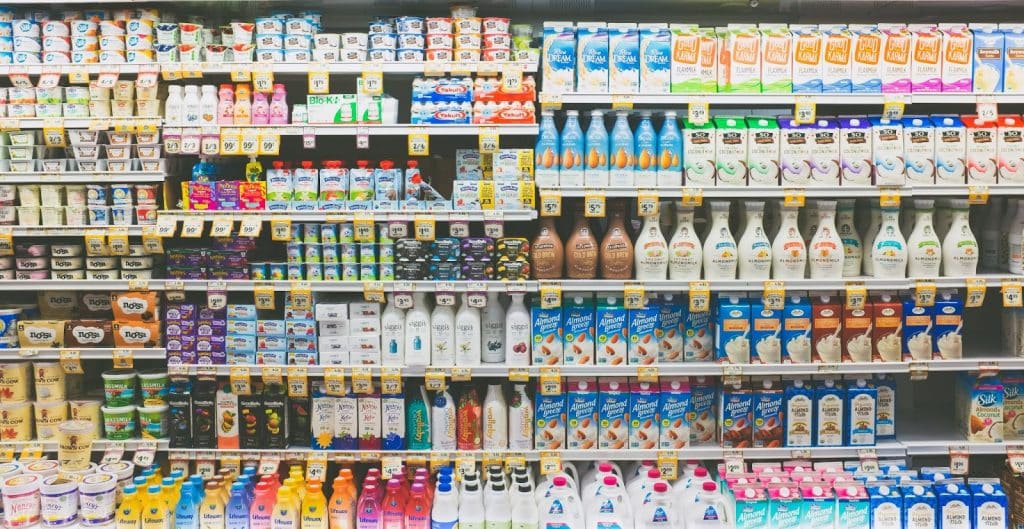
When it comes to selecting the right merchandising technique for your plant-based products, you don’t have to choose only one of the above approaches. Many stores use a combination of the above techniques to optimise shelf navigation and improve shopper experience, with the techniques used depending on the product type.
With merchandising, product volume and variety are vital. “Range and choice are key here,” says Lisa Gawthorne of Bravura Foods. “If consumers have a dislike for a product or it doesn’t appeal to their taste pallet, there must be other lines for them to try otherwise it can mean lost sales. Constantly scanning the market and keeping up to date with new ranges and new launches from existing brands is essential. The larger the category, the larger the choice.”
But too much choice, as well as too much of the same product, can also prove detrimental – it’s important not to overwhelm the consumer with either. Gawthorne adds: “Be mindful of SKU duplication. Yes, consumers want choice but not too much choice of the same thing.”

ProVeg Tips
Do you need trusted advice on how to merchandise and display your plant-based products in-store to maximise sales? Get in touch with ProVeg International at [email protected].
As well as rethinking shelf arrangement, ProVeg recommends the use of physical merchandising aids and signage to point out plant-based products, and make shelves easier to navigate.
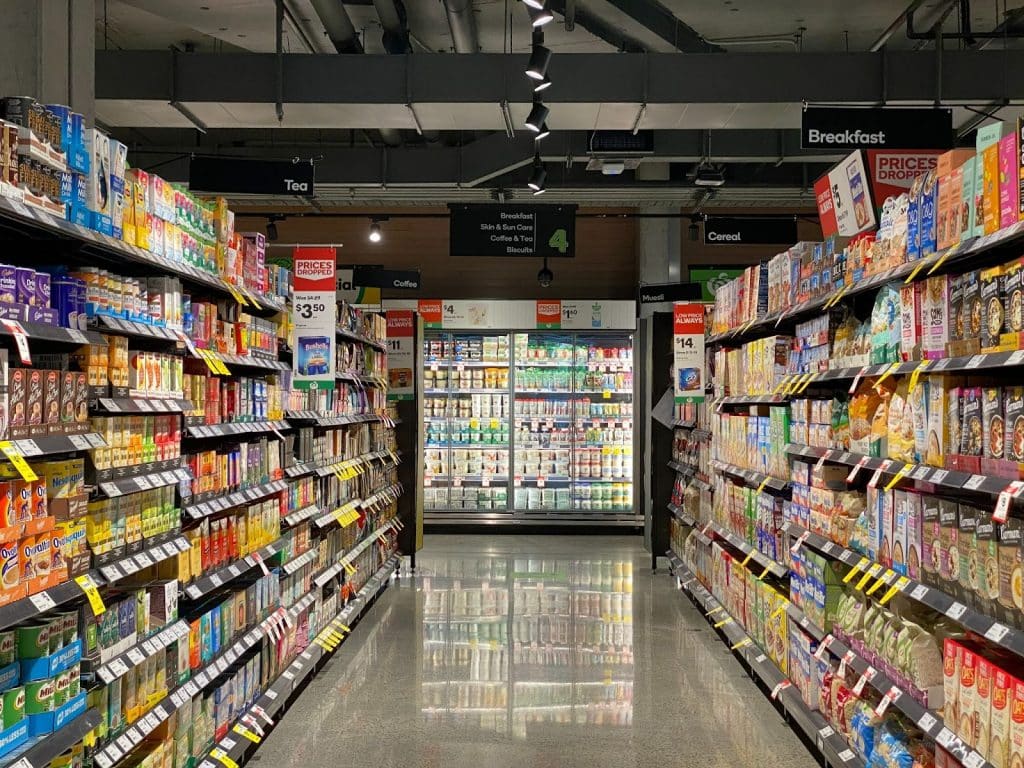
Gawthorne agrees: “In-store, it’s about simple yet effective tactics of clear branding or promotional messaging on shelf-edge label strips, the use of bus stops, wobblers (if allowed), and other point-of-sale items that catch the eye.”
Simple shelf dividers detailing the category need to be there at the bare minimum. Online, there are various tactics including banners, cart reminders, and promotions that can also be intensified and tied in with social-media efforts on Instagram and Facebook.”
Indy Kaur of Plant Futures adds: “Migros in Switzerland and Rewe in Germany do this well, where plant-based foods are given a green shelf-label or a ‘v’ logo throughout the store, plus signage for healthier/sustainable plant-based foods making it visible which lines are vegan. We are yet to see this in the UK and it is something to be considered. Training store staff is also vital as many are also new to plant-based.”
Key insights:
- Make shelves and aisles as easy to navigate as possible. You can do this by using visual-merchandising techniques like colour- and brand-blocking, and vertical- and cross-merchandising. Test what works best for your shoppers and apply what brings in the most sales and customer retention.
- Stock the right number of products – offer a wide range of plant-based products and brands but avoid too much duplication. This will save on shelf space allowing you to stock more variety of products.
3. Promote plant-based products next to animal-based products in promotional materials
Visibility of products is key when it comes to increasing plant-based purchases. After all, how will your consumers know to buy your products if they: 1) don’t know they exist, 2) cannot find them, and 3) do not think that they are suitable for or aimed at them?
There’s also a barrier in terms of knowledge and guidance surrounding plant-based food and drink. In a recent Pan-European survey by ProVeg, 48% of flexitarian respondents agreed with the statement ‘I need more information about plant-based food products’.21 The nutritional value of plant-based alternatives and how to cook them are both aspects of this.
Happily, all this and more can be easily achieved through the use of in-store and online promotional materials. Here are some best practice examples.
Leaflets and magazines
- Regularly include plant-based items in in-store promotional materials (such as leaflets, recipe cards, flyers, and supermarket-own magazines) that highlight offers, discounts, deals, and ‘special’ products. Whenever an animal-based product is featured, be sure to display a plant-based alternative alongside it. By doing so, you increase the visibility of plant-based products and, thus, normalise them to flexitarian and plant-forward consumers.
- Vegan and vegetarian-specific leaflets are good, but they don’t speak to your core audience of flexitarians, only serving to ‘other’ your plant-based category. If you use them in-store, consider doing so more frequently to ‘normalise’ rather than ‘other’ the plant-based products featured.
- If you have your own retailer-magazine, add a plant-based section that features plant-based recipes using your stocked products, as well as nutritional information and chef or nutritionist Q&As.
In-store signage and online banners
- When launching new plant-based products in store, use signage at aisle entrances, above aisles and in other areas of the store to direct customers to find these products. Online, use banners with links that take customers straight to the plant-based products you want to push.
- Whenever you feature an animal-based product offer in-store or online, be sure to feature an appropriate plant-based product option alongside it.
Key insights:
- When the top runner in a leaflet is animal-based, always position a vegan alternative next to it.
- Allocate more time to multi-category, plant-based offers, including plant-based by design.
- When launching plant-based products in store or online, place offers in promotional materials and on signage throughout the store and web platform.
4. Create a unique experience for the shopper
Shoppers are inundated with options in supermarkets, making it difficult for any one product or category of products to stand out, if it’s not a customer’s usual go-to. So, how can you grab the attention of flexitarians, leading to more purchases?
One effective way to do this is to create a unique experience for the shopper to gain both trust and familiarity, helping them to actively engage with the products and want to do so again in the future. The best ways to do this are to:
Create a unique customer experience through taste
Research has shown that taste is the primary motivator for plant-based food purchases,22 and luckily, the food produced by many meat- and dairy-free brands is really tasty! But not all consumers know this yet.23 If you can get consumers to taste your products for free, they will soon realise that any misconceptions they have about plant-based foods are unwarranted.
In an interview with ProVeg, David Pannell, Co-Founder of Vegan Business Tribe agreed: “The biggest obstacle that retailers face with products that are obviously marketed as plant-based alternatives is lack of familiarity and trust. When facing a squeeze on their pockets, consumers are less likely to take a chance on an unfamiliar product and so stick to what they know and are sure of. This means that sampling and demonstration is really important when introducing a new product – and often the brands will get involved themselves, making-up serving suggestions in-store for consumers to try.”
Research shows that about 75% of consumers who receive freebies go on to remember the brand name and hold a positive association with that company,24 which, in turn, lowers the consumer barrier to purchase the product themselves.
The most important thing is taste and experience. That’s why you have to give them the chance to try it.”
Create a unique experience through shop-in-shops
Back in 2021, UK-based supermarket chain ASDA announced a partnership with vegan concept creator Kbox Global, to trial a vegan butcher counter, Veelicious, at its Watford store. For six weeks, starting during Veganuary (a month-long go-vegan challenge), Veelicious sat next to the animal-meat butcher counter to offer customers a regular plant-based meat offering, including meat-free bacon, burgers and meat-balls, as well as a selection of dairy-free cheeses. The shop-in-shop made it easy for customers to find meat-free alternatives that were more difficult to locate elsewhere in the store.
Using the novelty shop-in-shop, ASDA gave consumers a memorable experience and raised the profile of their plant-based products, encouraging shoppers to make plant-based purchases – some for the first time.
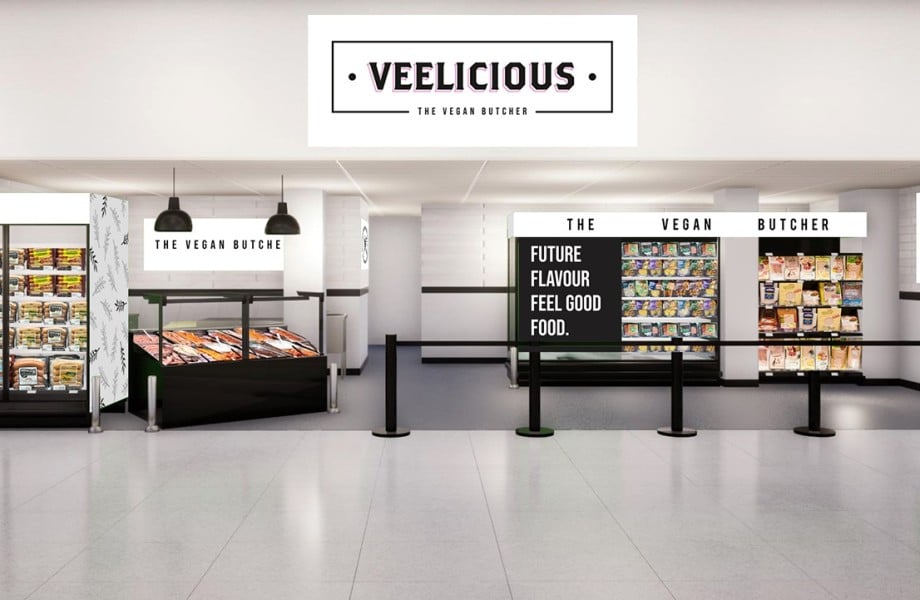
Preyash Thakrar, ASDA’s Chief Strategy Officer, commented on the trial: “The demand for vegan products is on the rise and we have seen a surge in people seeking out ways to easily enjoy a plant-based lifestyle. We recognised the importance of helping our customers with their Veganuary journey, which included partnering with Kbox to trial Veelicious in our Watford store.
“Across our product range, we [offered] many options for vegans and flexitarians… ensuring that our customers [didn’t] have to compromise on quality, taste or value when following a plant-based lifestyle. Veelicious [was] a ‘test and learn’ trial to help us understand what resonates with customers to enable us to enhance our plant-based proposition.”25
Elsewhere in Europe, other retailers are following suit. Back in February of this year French supermarket chain Carrefour opened the country’s first vegan butcher shop in a select number of its stores. The counter, which sells plant-based meats by weight rather than pre-packaged, appeals to traditional purchasing behaviours related to animal-based meats, making plant-based alternatives feel more familiar to shoppers. The initial trial saw great success, and has since expanded to include 12 plant-based meat stands, after opening with just four.
Key insights:
- Set up a tasting counter near your milk or protein aisles to encourage consumers to try your plant-based products.
- Offer the consumer a unique experience where they can sample and purchase your plant-based products in a novelty setting.
Conclusion
Retailers can increase their plant-based product sales and drive revenues through four simple acts:
- Promote plant-based products next to animal-based products in-store and online.
- Change the shelf placement of products for easier navigation.
- Promote plant-based products next to animal-based products in promotional materials.
- Create a unique experience for the shopper.
If you’re looking to learn how to attract more customers and instigate a greater number of plant-based purchases, ProVeg can help. Get in touch to talk over and develop your plant-based strategy by emailing us at [email protected].
Note: ProVeg conducts exclusive interviews with a wide range of industry professionals for its New Food Hub white papers. Unless an alternative citation is provided, quotations are from those interviews. Some interviewees wished to remain anonymous.
References
- Plant-based food market value worldwide 2030 (2022). Statista. Available at https://www.statista.com/statistics/1280394/global-plant-based-food-market-value Accessed 2022-10-18
- Plant-Based Eating: Trend or Fad? (2022). Acosta. Available at: https://www.acosta.com/news/new-acosta-report-finds-40-of-shoppers-buy-plant-based-products Accessed 2022-10-18
- Plant-based Foods: Will They Stay or Will They Go? (2019) The NPD Group. Available at: https://www.npd.com/news/press-releases/2019/plant-based-foods-will-they-stay-or-will-they-go/. Accessed 2022-10-18.
- Smart Protein Project (2021): What consumers want: A survey on European consumer attitudes towards plant-based foods. Country specific insights. European Union’s Horizon 2020 research and innovation programme (No 862957). Available at: https://smartproteinproject.eu/consumer-attitudes-plant-based-food-report/. Accessed 2022-10-18.
- Smart Protein Project (2021): What consumers want: A survey on European consumer attitudes towards plant-based foods. Country specific insights. European Union’s Horizon 2020 research and innovation programme (No 862957). Available at: https://smartproteinproject.eu/consumer-attitudes-plant-based-food-report/. Accessed 2022-10-18.
- Smart Protein Project (2021): What consumers want: A survey on European consumer attitudes towards plant-based foods. Country specific insights. European Union’s Horizon 2020 research and innovation programme (No 862957). Available at: https://smartproteinproject.eu/consumer-attitudes-plant-based-food-report/. Accessed 2022-10-18
- Smart Protein Project (2021): What consumers want: A survey on European consumer attitudes towards plant-based foods. Country specific insights. European Union’s Horizon 2020 research and innovation programme (No 862957). Available at: https://smartproteinproject.eu/consumer-attitudes-plant-based-food-report/. Accessed 2022-10-18
- Segregation or integration – Ranging plant-based products to drive sales (2021). Available at: https://www.igd.com/articles/article-viewer/t/segregation-or-integration-ranging-plant-based-products-to-drive-sales/i/27924 Accessed 2022-10-18.
- Plant-Based Meat Sales Increase An Average of 23% When Sold in the Meat Department (2020). Plant-Based Foods Association. Available at: https://www.plantbasedfoods.org/plant-based-meat-sales-increase-an-average-of-23-when-sold-in-the-meat-department Accessed 2022-10-18.
- Plant-Based Meat Sales Increase An Average of 23% When Sold in the Meat Department (2020). Plant-Based Foods Association. Available at: https://www.plantbasedfoods.org/plant-based-meat-sales-increase-an-average-of-23-when-sold-in-the-meat-department Accessed 2022-10-18.
- Plant-Based Meat Sales Increase An Average of 23% When Sold in the Meat Department (2020). Plant-Based Foods Association. Available at: https://www.plantbasedfoods.org/plant-based-meat-sales-increase-an-average-of-23-when-sold-in-the-meat-department Accessed 2022-10-18.
- Greggs (n.d.): At a Glance. Available at: https://corporate.greggs.co.uk/at-a-glance Accessed 2022-10-18.
- Chiorando, M. (2019): Greggs Vegan Sausage Roll Has More Protein Than Its Meat Version. Available at: https://plantbasednews.org/lifestyle/greggs-vegan-sausage-roll-more-protein-meat-version/ Accessed 2022-10-18.
- Barrie, J. (2019): Greggs’ new vegan sausage roll has boosted the whole company’s sales by 14 per cent. Available at: https://inews.co.uk/news/consumer/greggs-vegan-sausage-roll-sales-boosted-14-per-cent-259937 Accessed 2022-10-18.
- The Independent (2019): Greggs’ vegan sausage roll drives bumper 58% rise in profits. Available at: https://www.independent.co.uk/news/business/news/greggs-profits-vegan-sausage-rolls-rise-growth-a9027356.html Accessed 2022-10-18.
- Thaler, R. H., Sunstein, C. R., & Balz, J. P. (2013): Choice architecture. Cited in Behavioral Economics: Choice architecture. Available at: https://www.behavioraleconomics.com/resources/mini-encyclopedia-of-be/choice-architecture/ Accessed 2022-10-18.
- A Menu for Change (2020). The Behavioural Insights Team. Available at: https://www.bi.team/wp-content/uploads/2020/03/BIT_Report_A-Menu-for-Change_Webversion_2020.pdf.pdf Accessed 2022-10-18.
- Choice architecture in food services (2022) ProVeg Corporate. Available at: https://corporate.proveg.com/article/choice-architecture-in-food-services/ Accessed 2022-10-18
- 4 Merchandising Techniques All Retailers Should Know (2022). Dot Activ. Available at: https://www.dotactiv.com/blog/merchandising-techniques Accessed 2022-10-18.
- 4 Merchandising Techniques All Retailers Should Know (2022). Dot Activ. Available at: https://www.dotactiv.com/blog/merchandising-techniques Accessed 2022-10-18.
- Smart Protein Project (2021): ‘What consumers want: A survey on European consumer attitudes towards plant-based foods. Country specific insights,’ European Union’s Horizon 2020 research and innovation programme (No 862957). Available at: https://smartproteinproject.eu/consumer-attitudes-plant-based-food-report/ Accessed 2022-10-18.
- Parry, J., & Szejda, K. (2019): How to drive plant-based food purchasing: Key findings from a Mindlab study into implicit perceptions of the plant-based category. The Good Food Institute. Available at:https://go.gfi.org/Mindlab-Strategic-Recommendations Accessed 2022-10-18.
- Smart Protein Project (2021): ‘What consumers want: A survey on European consumer attitudes towards plant-based foods. Country specific insights,’ European Union’s Horizon 2020 research and innovation programme (No 862957). Available at: https://smartproteinproject.eu/consumer-attitudes-plant-based-food-report/ Accessed 2022-10-18.
- ASI and Identity Works cited in Wood, M. (2017): Branded Giveaways And Other Promotional Products: Do They Still Have An Impact? Available at: https://www.forbes.com/sites/allbusiness/2017/12/14/branded-giveaways-and-other-promotional-products-do-they-still-have-an-impact/?sh=66c893ae7790 Accessed 2022-10-18
- Asda trials vegan butcher concept as plant-based eating grows in popularity(2021). ASDA. Available at: https://corporate.asda.com/newsroom/2021/01/05/asda-trials-vegan-butcher-concept-as-plant-based-eating-grows-in-popularity Accessed 2022-10-18.
